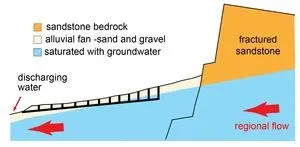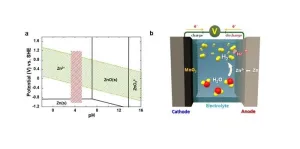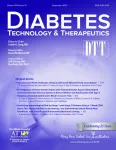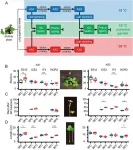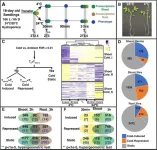(Press-News.org) Contributed by Emily Zawacki
Pittsburgh, Pa., USA: With its low quantities of rain and soaring high temperatures, the Sahara Desert is often regarded as one of the most extreme and least habitable environments on Earth. While the Sahara was periodically much greener in the distant past, an ancient society living in a climate very similar to today’s found a way to harvest water in the seemingly dry Sahara—thriving until the water ran out.
New research that will be presented Monday, 16 Oct., at the Geological Society of America’s GSA Connects 2023 meeting describes how a series of serendipitous environmental factors allowed an ancient Saharan civilization, the Garamantian Empire, to extract groundwater hidden in the subsurface, sustaining the society for nearly a millennia until the water was depleted.
“Societies rise and fall at the pleasure of the physical system, such that there are special features that let humanity grow up there,” says Frank Schwartz, professor in the School of Earth Sciences at The Ohio State University and lead author of the research study.
Monsoon rains had transformed the Sahara into a comparatively lush environment between 11,000 and 5,000 years ago, providing surface water resources and habitable environments for civilizations to thrive. When the monsoon rains stopped 5,000 years ago, the Sahara turned back into a desert, and civilizations retreated from the area—aside from an unusual outlier.
The Garamantes lived in the southwestern Libyan desert from 400 BCE to 400 CE under nearly the same hyper-arid conditions that exist there today and were the first urbanized society to become established in a desert that lacked a continuously flowing river. The surface water lakes and rivers of the “Green Sahara'' times were long gone by the time the Garamantes arrived, but there was luckily water stored underground in a large sandstone aquifer—potentially one of the largest aquifers in the world, according to Schwartz.
Camel trade routes from Persia through the Sahara brought the Garamantes technology on how to harvest groundwater using foggara or qanats. This method involved digging a slightly inclined tunnel into a hillside, to just below the water table. Groundwater would then flow down the tunnel and into irrigation systems. The Garamantes dug a total of 750 km of underground tunnels and vertical access shafts to harvest groundwater, with the greatest construction activity occurring between 100 BCE and 100 CE.
Schwartz integrates prior archaeological research with hydrologic analyses to understand how the local topography, geology, and unique runoff and recharge conditions produced the ideal hydrogeologic conditions for the Garamantes to be able to extract groundwater.
“Their qanats shouldn’t have actually worked, because the ones in Persia have annual water recharge from snowmelt, and there was zero recharge here,” says Schwartz.
The Garamantes had a significant streak of environmental luck, with the earlier wetter climate, appropriate topography, and unique groundwater settings, which made groundwater available with foggara technology. However, their luck ran out when groundwater levels fell below the foggara tunnels.
According to Schwartz, two trends are particularly concerning. First, extreme environments are becoming more prevalent around the world in countries like Iran. Second, it has become more common to use groundwater unsustainably.
“As you look at modern examples like the San Joaquin Valley, people are using the groundwater up at a faster rate than it’s being replenished,” says Schwartz. “California had a great wet winter this year, but that followed 20 years of drought. If the propensity for drier years continues, California will ultimately run into the same problem as the Garamantians. It can be expensive and ultimately impractical to replace depleted groundwater supplies.”
With no new water to replenish the aquifer and no surface water available, lack of water led to the downfall of the Garamantian Empire. The Garamantes serve as a cautionary tale for the power of groundwater as a resource, and the danger of its overuse.
Living in Extreme Environments: Hydrologic Serendipity and the Garamantian Empire of the Sahara Desert
Contact: Frank Schwartz, schwartz.11@osu.edu
87: T142. Achieving Groundwater Security across Local-to-Regional Scales in the Anthropocene
Mon., 16 Oct. 2023, 8:05–8:25 a.m.
###
END
How an ancient society in the Sahara Desert rose and fell with groundwater
New research presented at GSA Connects 2023
2023-10-13
ELSE PRESS RELEASES FROM THIS DATE:
Most Canadians with arthritis and disabling chronic pain are in excellent mental health
2023-10-13
Toronto, Canada
A new study published by researchers at the University of Toronto indicates a very high level of resilience among Canadians with arthritis whose activities were restricted due to pain.
The vast majority (76%) of these individuals were free of any mental illness in the past year, including depression. The paper was published online this week in PLOS ONE.
More than half (56%) of the respondents went beyond just being free of psychiatric disorders to achieving excellent mental health. ...
Caution, ocelot crossing: special wildlife exits on busy roads help protect endangered cat
2023-10-13
The Texas ocelot (Leopardus pardalis albescens) is endangered due to historic hunting, habitat loss, inbreeding, and traffic collisions. Today, only between 50 and 80 ocelots remain in the US, exclusively in Willacy and Cameron counties in southern Texas. These two populations are isolated from the larger one in northwestern Mexico by highways and urban development.
“Here we show that a range of species, including middle-sized carnivores such as bobcats and coyotes, successfully use wildlife exits, a new type of mitigation structure specifically designed for the US endangered ...
A cheaper, safer alternative to lithium-ion batteries: Aqueous rechargeable batteries
2023-10-13
This summer, the planet is suffering from unprecedented heat waves and heavy rainfalls. Developing renewable energy and expanding associated infrastructure has become an essential survival strategy to ensure the sustainability of the planet in crisis, but it has obvious limitations due to the volatility of electricity production, which relies on uncertain variables like labile weather conditions. For this reason, the demand for energy storage systems (ESS) that can store and supply electricity as needed is ever-increasing, but lithium-ion batteries (LIBs) currently employed in ESS are not only highly expensive, but also prone to potential fire, so there is an urgent need to ...
Most accurate test to date developed to measure biological aging
2023-10-13
A team of European researchers has developed a new test that can accurately measure biological aging in a clinical setting. The discovery was made while studying patients for the aging effects of chronic kidney disease.
The new test is an epigenetic clock – a type of biochemical assessment that looks at DNA to understand how well the body is aging in contrast to its chronological age – and is the first of these cutting-edge tests to be proven to perform accurately in a clinical setting, in ...
International experts push for innovation to improve stroke recovery
2023-10-13
Scientists from The Florey are among the world’s leading stroke experts who have mapped out how researchers and clinicians can improve outcomes for people who have survived a stroke.
The third Stroke Recovery and Rehabilitation Roundtable, an initiative of the International Stroke Recovery and Rehabilitation Alliance, has made a series of key recommendations about managing fatigue, measuring mobility, harnessing non-invasive brain stimulation technologies and improving how trials are designed. The highly influential gathering of world stroke experts published their findings in a special ...
Using closed-loop in type 1 pregnancy associated with type 1 diabetes
2023-10-13
A new study endorses closed-loop use in type 1 diabetes pregnancy and highlights how the technology can facilitate positive pregnancy experiences. The study is published in the peer-reviewed journal Diabetes Technology & Therapeutics (DTT). Click here to read the article now.
Julia Lawton, from the University of Edinburgh, and coauthors, on behalf of the AiDAPT Collaborative Group, interviewed closed-loop participants in the Automated insulin Delivery Amongst Pregnant women with T1D (AiDAPT) trial. “Women described how closed-loop lessened the physical and mental demands ...
A step towards understanding early interventions for Huntington’s Disease
2023-10-13
Huntington’s Disease is the most common neurodegenerative disorder controlled by a single gene and is characterized by motor and cognitive deficits and psychiatric symptoms. Currently, no treatments can stop or reverse the disease, but new research from Boston Children’s Hospital suggests that there might be a way to protect the brain and prevent or slow cognitive decline.
Research from the lab of Beth Stevens, PhD suggests that parts of the immune system – complement proteins and microglia – mediate the loss of specific synapses connecting the brain’s cortex and striatum. The findings, recently published in Nature Medicine, could ...
Landmark publication calls for increased attention to workplace mental health
2023-10-13
A landmark scientific article on the workplace as a major determinant of health is published today (Thursday, 12 October) in The Lancet, and reveals a global picture of the work-related causes of mental health conditions.
Carried by University College Cork (UCC) researchers for the Lancet Series on work and health, the paper illustrates that major progress in population health can be made by an increased focus on improving people’s work environments.
The paper, ‘Work-related causes of mental health conditions and interventions for their improvement in workplaces’, ...
DNA methylation: The hidden mechanism enabling plants to adapt in a warmer world
2023-10-13
As global warming continues to redefine ecosystems, plants are increasingly tasked with swift adaptation to ensure their survival. One primary mechanism facilitating such rapid adaptation is epigenetic memory, specifically DNA methylation. DNA methylation, a form of epigenetic modification, involves the addition of a methyl group to the cytosine bases of the DNA, altering its accessibility in chromatin and modulating gene expression. In the context of a warming climate, changes in DNA methylation can be triggered by environmental factors like increased temperature. Such epigenetic adaptations ...
Unlocking the secrets of cold tolerance: a deep dive into tomato plants' molecular responses to chilling stress
2023-10-13
Cold sensitivity poses a significant challenge for certain essential crops. While there's an indication that these plants may possess cold acclimation capabilities, the molecular dynamics, particularly involving the CRT binding factor (CBF) family, are not fully explored. One primary concern has been the disparity in cold tolerance between temperate plants and tropical species such as the tomato. Additionally, the accumulation of small metabolites, termed cryoprotectants, plays a crucial role in enabling plants to resist damage from low temperatures. Adding ...
LAST 30 PRESS RELEASES:
Scientists to ‘spy’ on cancer- immune cell interactions using quantum technology breakthrough
Tech savvy users have most digital concerns
Making lighter work of calculating fluid and heat flow
Normalizing blood sugar can halve heart attack risk
Lowering blood sugar cuts heart attack risk in people with prediabetes
Study links genetic variants to risk of blinding eye disease in premature infants
Non-opioid ‘pain sponge’ therapy halts cartilage degeneration and relieves chronic pain
AI can pick up cultural values by mimicking how kids learn
China’s ecological redlines offer fast track to 30 x 30 global conservation goal
Invisible indoor threats: emerging household contaminants and their growing risks to human health
Adding antibody treatment to chemo boosts outcomes for children with rare cancer
Germline pathogenic variants among women without a history of breast cancer
Tanning beds triple melanoma risk, potentially causing broad DNA damage
Unique bond identified as key to viral infection speed
Indoor tanning makes youthful skin much older on a genetic level
Mouse model sheds new light on the causes and potential solutions to human GI problems linked to muscular dystrophy
The Journal of Nuclear Medicine ahead-of-print tip sheet: December 12, 2025
Smarter tools for peering into the microscopic world
Applications open for funding to conduct research in the Kinsey Institute archives
Global measure underestimates the severity of food insecurity
Child survivors of critical illness are missing out on timely follow up care
Risk-based vs annual breast cancer screening / the WISDOM randomized clinical trial
University of Toronto launches Electric Vehicle Innovation Ontario to accelerate advanced EV technologies and build Canada’s innovation advantage
Early relapse predicts poor outcomes in aggressive blood cancer
American College of Lifestyle Medicine applauds two CMS models aligned with lifestyle medicine practice and reimbursement
Clinical trial finds cannabis use not a barrier to quitting nicotine vaping
Supplemental nutrition assistance program policies and food insecurity
Switching immune cells to “night mode” could limit damage after a heart attack, study suggests
URI-based Global RIghts Project report spotlights continued troubling trends in worldwide inhumane treatment
Neutrophils are less aggressive at night, explaining why nighttime heart attacks cause less damage than daytime events
[Press-News.org] How an ancient society in the Sahara Desert rose and fell with groundwaterNew research presented at GSA Connects 2023

